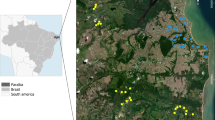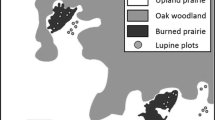Abstract
Lygodium microphyllum is one of the most noxious invasive plants in Florida, USA, smothering native vegetation in cypress swamps, pine flatwoods, and Everglades tree islands and altering fire regimes. The eriophyid mite Floracarus perrepae was introduced from Australia to help control L. microphyllum infestations. While F. perrepae exhibits high population growth rates in its native range, its population dynamics in Florida are unknown, particularly the dynamics that occur within the leaf roll galls the mite induces on the margins of leaves. Here, we monitored a shade house colony of F. perrepae in south Florida for 2 years to identify seasonal patterns and potential climate drivers of within-gall mite density. Gall dissections of mite-infested colony plants were performed monthly. Mite density within galls exhibited two cycles per year: a strong cycle that boomed in spring and busted in summer, and a weak cycle that moderately increased mite density in fall and declined in winter. Climate variables, particularly those related to wind speed, were positively associated with higher mite density. Our study sheds light on the within-gall dynamics of F. perrepae and suggests that the highest within-gall mite densities occur in the spring and fall.



Similar content being viewed by others
Data availability
The datasets generated during and/or analysed during the current study are available from the corresponding author on reasonable request.
References
Beckner J (1968) Lygodium microphyllum, another fern escaped in Florida. Am Fern J 58:93. https://doi.org/10.2307/1546255
Boughton AJ, Pemberton RW (2011) Limited field establishment of a weed biocontrol agent, Floracarus perrepae (Acariformes: Eriophyidae), against old world climbing fern in Florida—a possible role of mite resistant plant genotypes. Environ Entomol 40:1448–1457. https://doi.org/10.1603/EN11030
FLEPPC (2019) Florida Exotic Pest Plant Council’s 2019 List of Invasive Plant Species. https://www.fleppc.org/list/list.htm
Freeman TP, Goolsby JA, Ozman SK, Nelson DR (2005) An ultrastructural study of the relationship between the mite Floracarus perrepae Knihinicki & Boczek (Acariformes: Eriophyidae) and the fern Lygodium microphyllum (Lygodiaceae). Aust J Entomol 44:57–61. https://doi.org/10.1111/j.1440-6055.2005.00425.x
Galvão AS, Melo JWS, Monteiro VB et al (2012) Dispersal strategies of Aceria guerreronis (Acari: Eriophyidae), a coconut pest. Exp Appl Acarol 57:1–13. https://doi.org/10.1007/s10493-012-9527-z
Garcia CA (2019) NonlinearTseries: nonlinear time series analysis. R package version 0.2.6. https://CRAN.R-project.org/package=nonlinearTseries
Goolsby JA, Wright AD, Pemberton RW (2003) Exploratory surveys in Australia and Asia for natural enemies of Old World climbing fern, Lygodium microphyllum: Lygodiaceae. Biol Control 28:33–46. https://doi.org/10.1016/S1049-9644(03)00054-9
Goolsby JA, Zonneveld R, Bourne A (2004) Prerelease assessment of impact on biomass production of an invasive weed, Lygodium microphyllum (Lygodiaceae: Pteridophyta), by a potential biological control agent, Floracarus perrepae (Acariformes: Eriophyidae). Environ Entomol 33:997–1002. https://doi.org/10.1603/0046-225X-33.4.997
Goolsby JA, Jesudasan RWA, Jourdan H et al (2005) Continental comparisons of the interaction between climate and the herbivorous mite, Floracarus perrepae (Acari: Eriophyidae). Fla Entomol 88:129–134. https://doi.org/10.1653/0015-4040(2005)088%5b0129:CCOTIB%5d2.0.CO;2
Lake EC, Smith MC, Pratt PD et al (2014) Dispersal and establishment of new populations of the biological control agent Floracarus perrepae (Acariformes: Eriophyidae) on Old World Climbing fern, Lygodium microphyllum (Polypodiales: Lygodiaceae). Fla Entomol 97:827–829. https://doi.org/10.1653/024.097.0271
Melo JWS, Lima DB, Sabelis MW et al (2014) Limits to ambulatory displacement of coconut mites in absence and presence of food-related cues. Exp Appl Acarol 62:449–461. https://doi.org/10.1007/s10493-013-9753-z
Mukwevho L, Olckers T, Simelane DO (2017) Establishment, dispersal and impact of the flower-galling mite Aceria lantanae (Acari: Trombidiformes: Eriophyidae) on Lantana camara (Verbenaceae) in South Africa. Biol Control 107:33–40. https://doi.org/10.1016/j.biocontrol.2017.01.009
Nasareen PN, Ramani N (2014) Seasonal variation in the population density of the gall mite, Aceria pongamiae Keifer 1966 (Acari: Eriophyidae) within the leaf galls of Pongamia pinnata (L.). J Entomol Zool Stud 2:126–130
Ozman SK, Goolsby JA (2005) Biology and phenology of the eriophyid mite, Floracarus perrepae, on its native host in Australia, Old World climbing fern, Lygodium microphyllum. Exp Appl Acarol 35:197–213. https://doi.org/10.1007/s10493-004-4186-3
Paynter Q, Bellgard S (2011) Understanding dispersal rates of invading weed biocontrol agents. J Appl Ecol 48:407–414. https://doi.org/10.1111/j.1365-2664.2010.01930.x
Paynter Q, Shaw RH (1997) Report on weed work for New Zealand. Project XB0879
Paynter Q, Gourlay AH, Rolando CA, Watt MS (2012) Dispersal of the Scotch broom gall mite Aceria genistae: implications for biocontrol. N Z Plant Prot 65:81–84
Pemberton RW, Ferriter AP (1998) Old World Climbing Fern (Lygodium microphyllum), a dangerous invasive weed in Florida. Am Fern J 88:165. https://doi.org/10.2307/1547769
Pemberton RW, Goolsby JA, Wright T (2002) Old World Climbing Fern. In: Van Driesche R, Lyon S, Blossey B, et al. (eds) Biological control of invasive plants in the eastern United States. USDA Forest Service Forest Health Technology Enterprise Team-2002-04, Morgantown, pp 139–147
Pratt PD, Pitcairn MJ, Oneto S et al (2019) Invasion of the gall mite Aceria genistae (Acari: Eriophyidae), a natural enemy of the invasive weed Cytisus scoparius, into California, USA and predictions for climate suitability in other regions using ecological niche modelling. Biocontrol Sci Technol 10:1–20. https://doi.org/10.1080/09583157.2019.1566440
R Development Core Team (2017) R: a language and environment for statistical computing. R Foundation for Statistical Computing. Vienna, Austria
Smith L, de Lillo E, Amrine JW (2010) Effectiveness of eriophyid mites for biological control of weedy plants and challenges for future research. Exp Appl Acarol 51:115–149. https://doi.org/10.1007/s10493-009-9299-2
U.S. Congress (2000) Comprehensive Everglades Restoration Plan
Acknowledgements
We thank A. Abdel-Kader, A. Carmona, K. Ducassi, C. Martinez, J. Murphy, and A. Pitcher for providing technical assistance. Funding was provided by the U.S. Department of Agriculture (USDA), the Florida Fish and Wildlife Conservation Commission, and the South Florida Water Management District and U.S. Army Corps of Engineers as part of the Comprehensive Everglades Restoration Plan. We thank Editor J. Bruin and three anonymous reviewers for their constructive feedback on the manuscript. Mention of trade names or commercial products in this publication is solely for the purpose of providing specific information and does not imply recommendation or endorsement by the USDA. USDA is an equal opportunity employer and provider.
Author information
Authors and Affiliations
Corresponding author
Additional information
Publisher's Note
Springer Nature remains neutral with regard to jurisdictional claims in published maps and institutional affiliations.
Rights and permissions
About this article
Cite this article
David, A.S., Jones, I.M. & Lake, E.C. Wind speed predicts population dynamics of the eriophyid mite Floracarus perrepae on invasive Old World climbing fern (Lygodium microphyllum) in a shade house colony. Exp Appl Acarol 78, 263–272 (2019). https://doi.org/10.1007/s10493-019-00391-3
Received:
Accepted:
Published:
Issue Date:
DOI: https://doi.org/10.1007/s10493-019-00391-3




